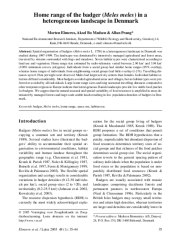Lutra 48(1)_Elmeros et al_2005

Home range of the badger (Meles meles) in a heterogeneous landscape in Denmark
Spatial organisation of badgers (Meles meles L. 1758) in a heterogeneous landscape in Denmark was studied during 1997-1999. The landscape was dominated by intensively managed agricultural and forest areas, traversed by streams surrounded with bogs and meadows. Seven habitat types were characterised according to land use and vegetation. Home range size estimated by radio-telemetry varied between 2.96 km2 and 3.94 km2 (100% minimum convex polygons). Individuals from a social group had similar home ranges (95% overlap), whereas home ranges of individuals from neighbouring social groups had little overlap (1-2%). Travelling distances up to 6.9 km per night were observed. Males had larger activity centres than females. Individual habitat selection differed considerably. Most badgers avoided agricultural areas and villages, but no habitat types were preferred or avoided by all individuals. Large home range sizes and long nocturnal travelling distances compared to other temperate regions in Europe indicate that heterogeneous Danish landscapes provide few stable food patches for badgers. We suggest that the natural seasonal and spatial variability of food resources is amplified in areas dominated by managed forests and large-scale arable lands resulting in low population densities of badgers in Denmark.